Abstract
1. In birds, prolonged cold exposure induces the development of a non-shivering thermogenesis (NST) of muscular origin that may result from an increase in ATP-dependent cycling of Ca2+ between the sarcoplasmic reticulum (SR) and the cytosol. 2. Because fatty acids are thought to play a significant role in NST, we investigated the effects of palmitic acid and related metabolites on skeletal SR Ca2+ uptake and release in ducklings. 3. Ca(2+)-ATPase activity, 45Ca2+ release and [3H]ryanodine-binding measurements indicated that palmitic acid was without effect on the Ca(2+)-ATPase and Ca2+ release channel. Palmitoyl carnitine and palmitoyl coenzyme A inhibited the Ca(2+)-ATPase at concentrations > 20 microM whereas both activated the Ca2+ release channel at concentrations < or = 20 microM in a dose-dependent manner. 4. Palmitoyl carnitine stimulated [3H]ryanodine binding to skeletal but not cardiac SR vesicles. Induction of 45Ca2+ release was observed with long-chain (C > or = 14) but not with short-chain acyl carnitines (C < or = 12). 5. Long-chain acyl carnitines accumulated significantly in duckling skeletal muscle during cold acclimation. Accordingly, these results suggest that long-chain acyl metabolites may modulate SR Ca2+ cycling and its associated thermogenesis in vivo.
Full text
PDF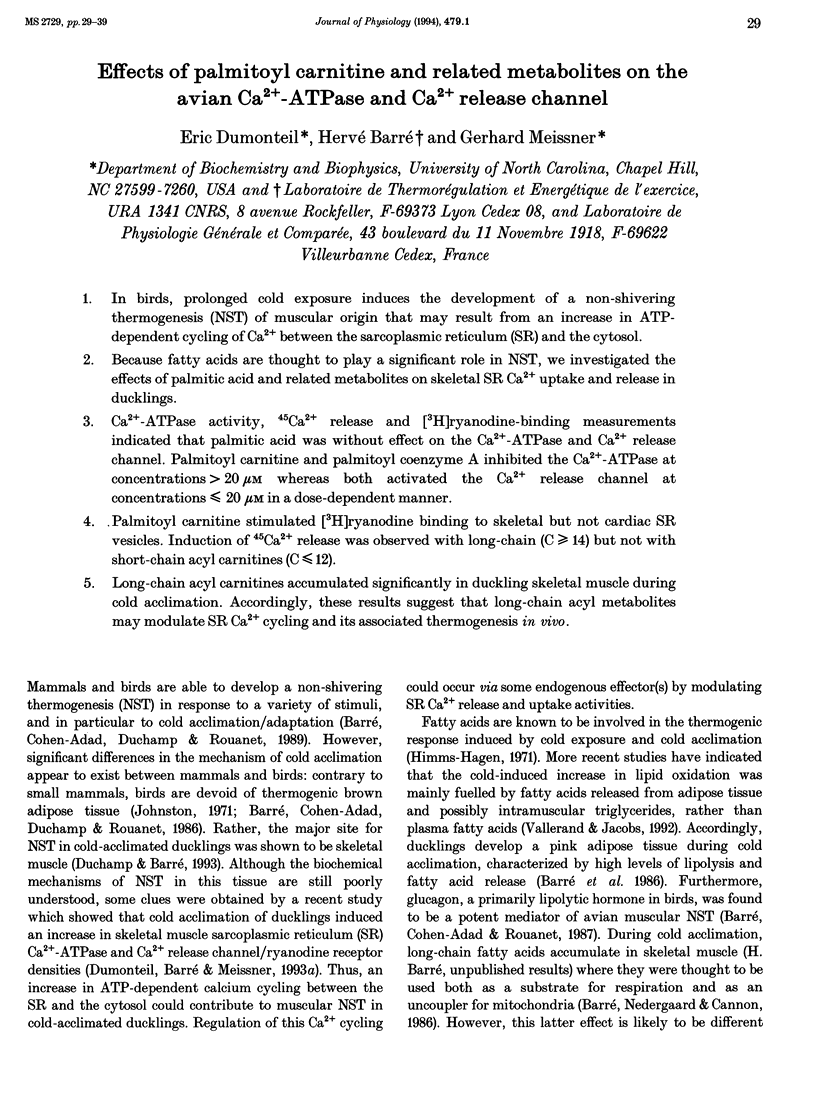
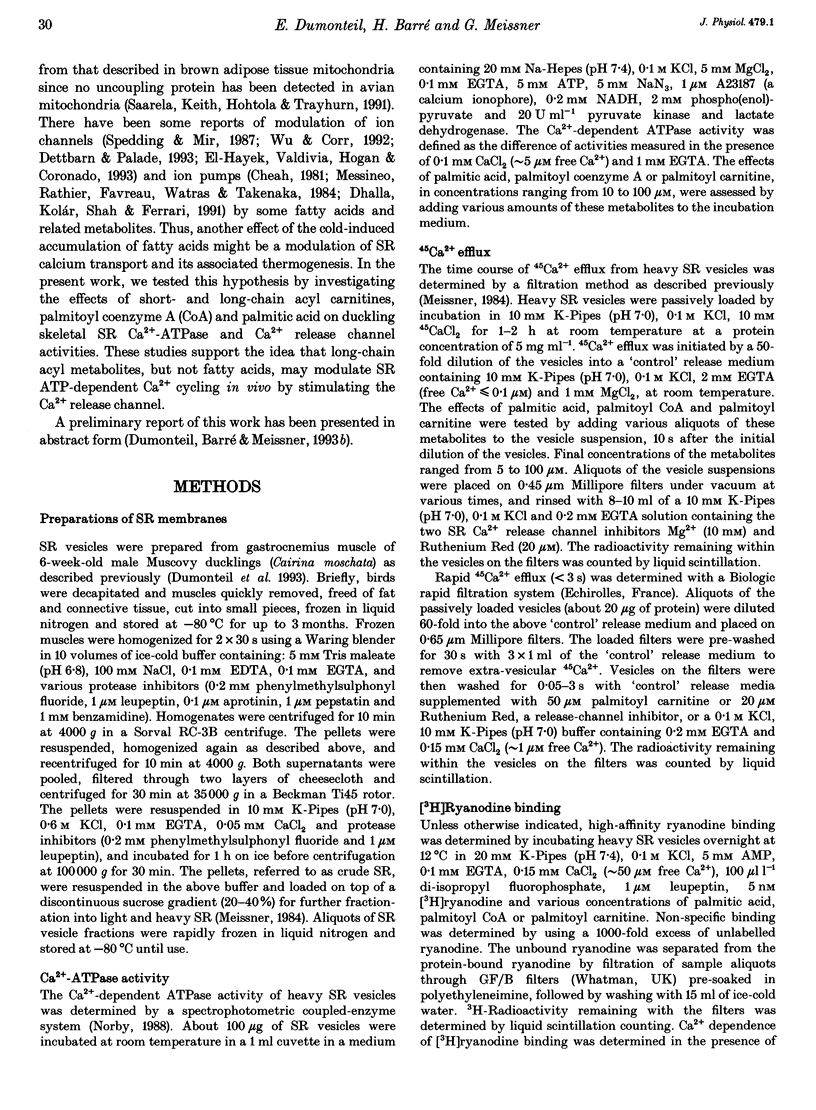
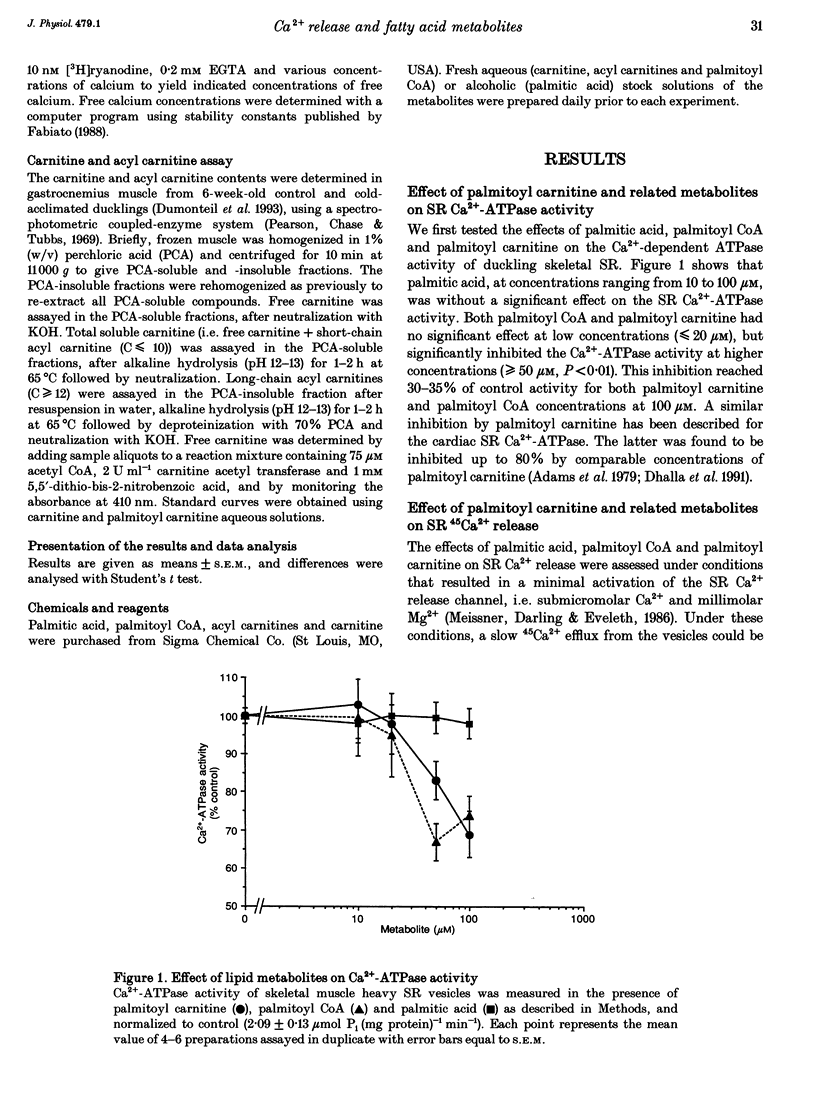

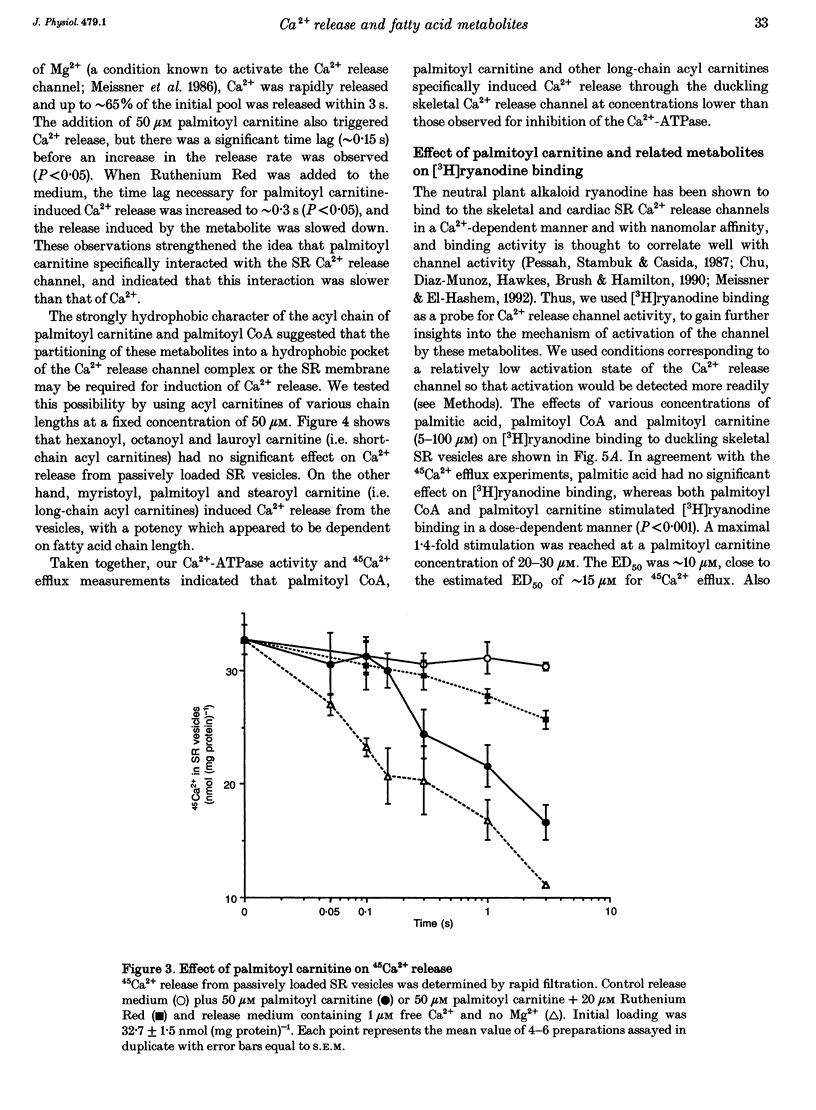
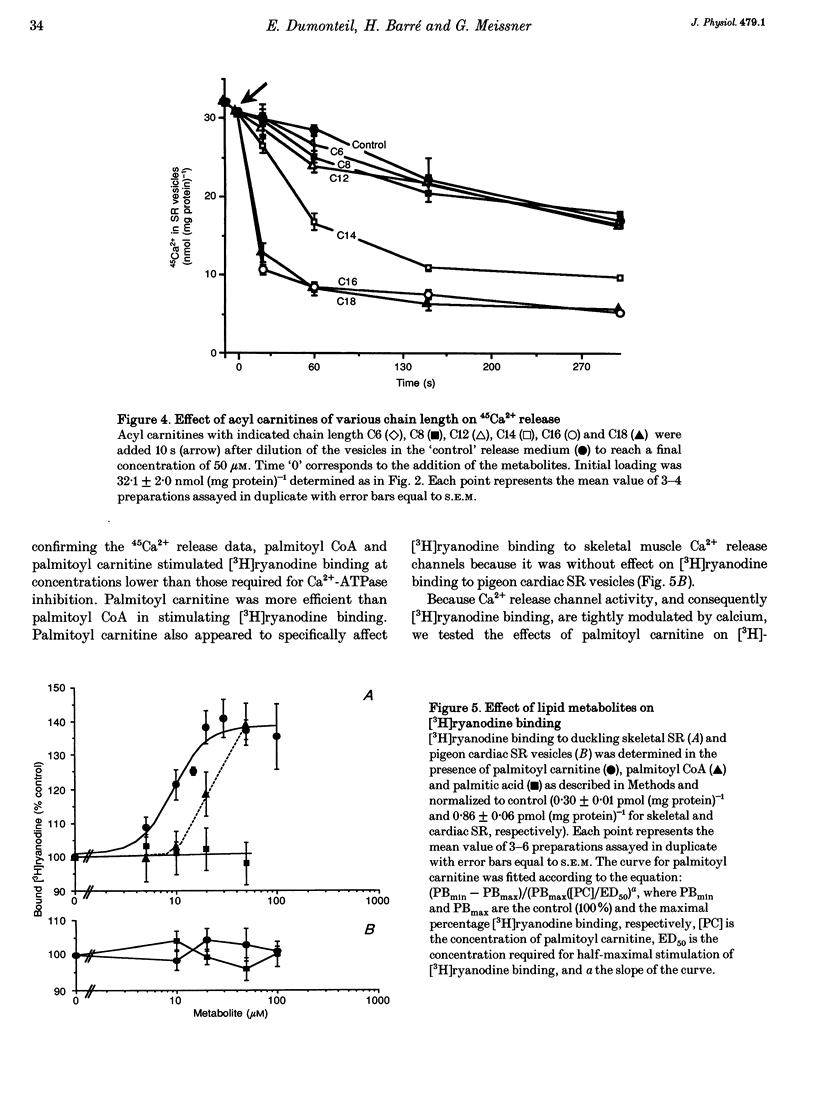
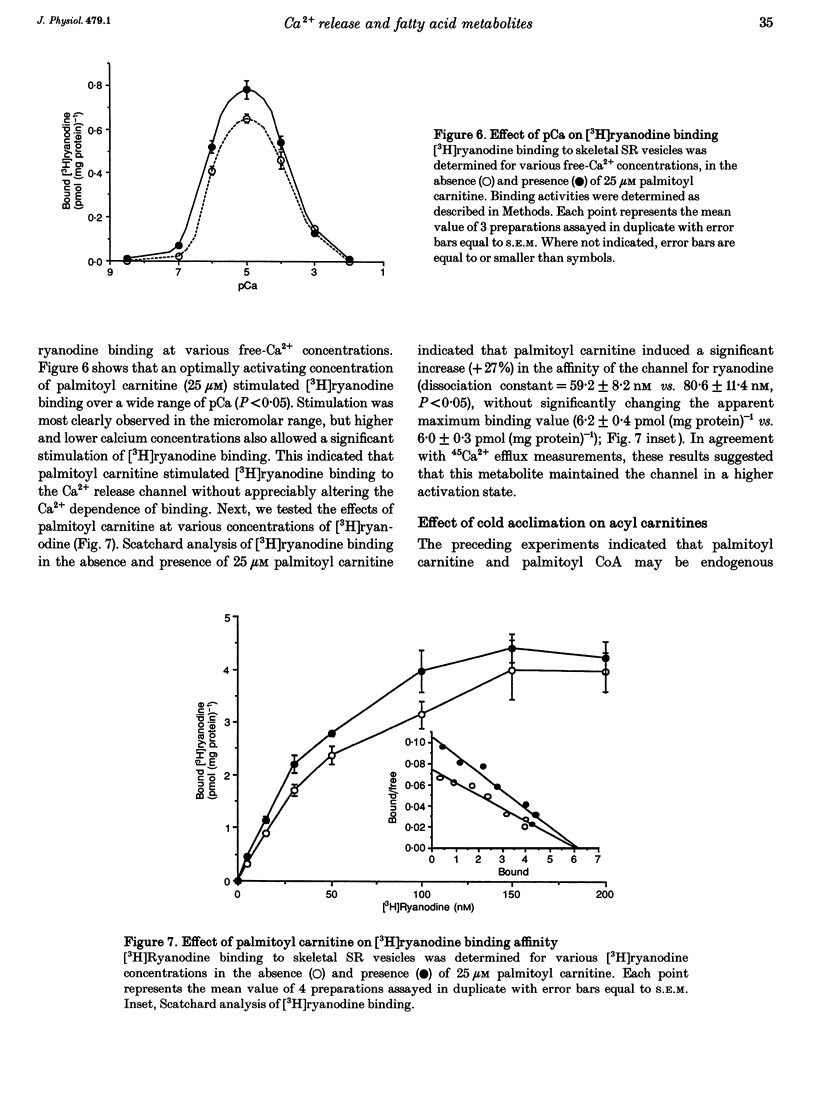

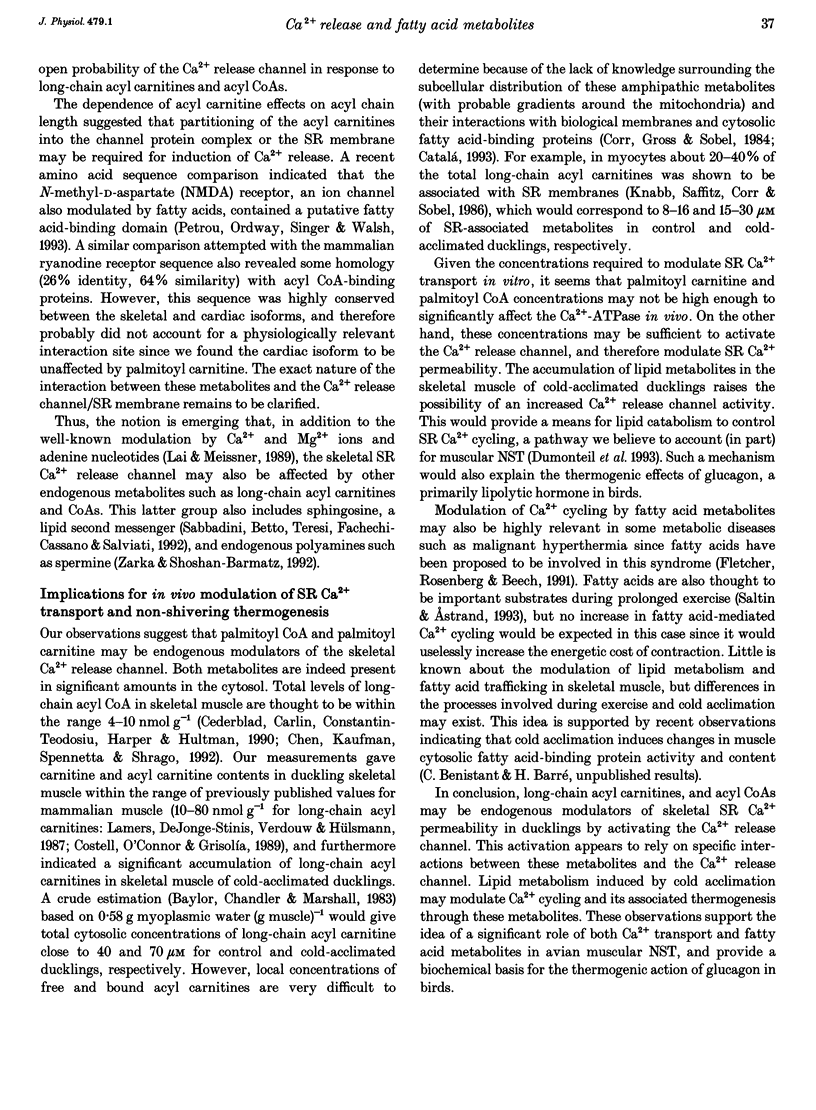

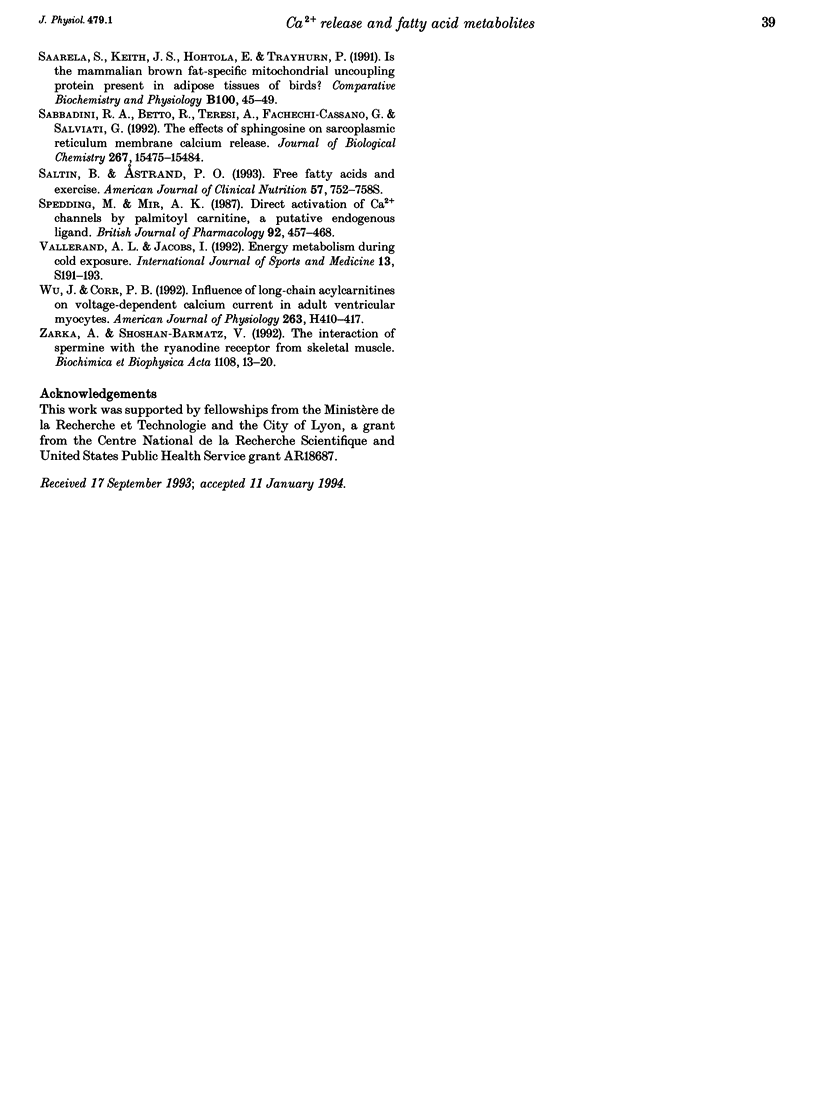
Selected References
These references are in PubMed. This may not be the complete list of references from this article.
- Adams R. J., Cohen D. W., Gupte S., Johnson J. D., Wallick E. T., Wang T., Schwartz A. In vitro effects of palmitylcarnitine on cardiac plasma membrane Na,K-ATPase, and sarcoplasmic reticulum Ca2+-ATPase and Ca2+ transport. J Biol Chem. 1979 Dec 25;254(24):12404–12410. [PubMed] [Google Scholar]
- Barré H., Cohen-Adad F., Duchamp C., Rouanet J. L. Multilocular adipocytes from muscovy ducklings differentiated in response to cold acclimation. J Physiol. 1986 Jun;375:27–38. doi: 10.1113/jphysiol.1986.sp016103. [DOI] [PMC free article] [PubMed] [Google Scholar]
- Barré H., Cohen-Adad F., Rouanet J. L. Two daily glucagon injections induce nonshivering thermogenesis in Muscovy ducklings. Am J Physiol. 1987 May;252(5 Pt 1):E616–E620. doi: 10.1152/ajpendo.1987.252.5.E616. [DOI] [PubMed] [Google Scholar]
- Barré H., Nedergaard J., Cannon B. Increased respiration in skeletal muscle mitochondria from cold-acclimated ducklings: uncoupling effects of free fatty acids. Comp Biochem Physiol B. 1986;85(2):343–348. doi: 10.1016/0305-0491(86)90010-6. [DOI] [PubMed] [Google Scholar]
- Baylor S. M., Chandler W. K., Marshall M. W. Sarcoplasmic reticulum calcium release in frog skeletal muscle fibres estimated from Arsenazo III calcium transients. J Physiol. 1983 Nov;344:625–666. doi: 10.1113/jphysiol.1983.sp014959. [DOI] [PMC free article] [PubMed] [Google Scholar]
- Catalá A. Interaction of fatty acids, acyl-CoA derivatives and retinoids with microsomal membranes: effect of cytosolic proteins. Mol Cell Biochem. 1993 Mar 24;120(2):89–94. doi: 10.1007/BF00926080. [DOI] [PubMed] [Google Scholar]
- Cederblad G., Carlin J. I., Constantin-Teodosiu D., Harper P., Hultman E. Radioisotopic assays of CoASH and carnitine and their acetylated forms in human skeletal muscle. Anal Biochem. 1990 Mar;185(2):274–278. doi: 10.1016/0003-2697(90)90292-h. [DOI] [PubMed] [Google Scholar]
- Cheah A. M. Effect of long chain unsaturated fatty acids on the calcium transport of sarcoplasmic reticulum. Biochim Biophys Acta. 1981 Nov 6;648(2):113–119. doi: 10.1016/0005-2736(81)90025-0. [DOI] [PubMed] [Google Scholar]
- Chen M. T., Kaufman L. N., Spennetta T., Shrago E. Effects of high fat-feeding to rats on the interrelationship of body weight, plasma insulin, and fatty acyl-coenzyme A esters in liver and skeletal muscle. Metabolism. 1992 May;41(5):564–569. doi: 10.1016/0026-0495(92)90221-u. [DOI] [PubMed] [Google Scholar]
- Chu A., Díaz-Muñoz M., Hawkes M. J., Brush K., Hamilton S. L. Ryanodine as a probe for the functional state of the skeletal muscle sarcoplasmic reticulum calcium release channel. Mol Pharmacol. 1990 May;37(5):735–741. [PubMed] [Google Scholar]
- Corr P. B., Gross R. W., Sobel B. E. Amphipathic metabolites and membrane dysfunction in ischemic myocardium. Circ Res. 1984 Aug;55(2):135–154. doi: 10.1161/01.res.55.2.135. [DOI] [PubMed] [Google Scholar]
- Costell M., O'Connor J. E., Grisolía S. Age-dependent decrease of carnitine content in muscle of mice and humans. Biochem Biophys Res Commun. 1989 Jun 30;161(3):1135–1143. doi: 10.1016/0006-291x(89)91360-0. [DOI] [PubMed] [Google Scholar]
- Dettbarn C., Palade P. Arachidonic acid-induced Ca2+ release from isolated sarcoplasmic reticulum. Biochem Pharmacol. 1993 Mar 24;45(6):1301–1309. doi: 10.1016/0006-2952(93)90283-3. [DOI] [PubMed] [Google Scholar]
- Dhalla N. S., Kolár F., Shah K. R., Ferrari R. Effects of some L-carnitine derivatives on heart membrane ATPases. Cardiovasc Drugs Ther. 1991 Feb;5 (Suppl 1):25–30. doi: 10.1007/BF00128240. [DOI] [PubMed] [Google Scholar]
- Duchamp C., Barré H. Skeletal muscle as the major site of nonshivering thermogenesis in cold-acclimated ducklings. Am J Physiol. 1993 Nov;265(5 Pt 2):R1076–R1083. doi: 10.1152/ajpregu.1993.265.5.R1076. [DOI] [PubMed] [Google Scholar]
- Dumonteil E., Barré H., Meissner G. Sarcoplasmic reticulum Ca(2+)-ATPase and ryanodine receptor in cold-acclimated ducklings and thermogenesis. Am J Physiol. 1993 Aug;265(2 Pt 1):C507–C513. doi: 10.1152/ajpcell.1993.265.2.C507. [DOI] [PubMed] [Google Scholar]
- Fabiato A. Computer programs for calculating total from specified free or free from specified total ionic concentrations in aqueous solutions containing multiple metals and ligands. Methods Enzymol. 1988;157:378–417. doi: 10.1016/0076-6879(88)57093-3. [DOI] [PubMed] [Google Scholar]
- Fletcher J. E., Rosenberg H., Beech J. Interactions of fatty acids with the calcium release channel in malignant hyperthermia. Adv Exp Med Biol. 1991;301:57–69. doi: 10.1007/978-1-4684-5979-1_6. [DOI] [PubMed] [Google Scholar]
- Hawkes M. J., Nelson T. E., Hamilton S. L. [3H]ryanodine as a probe of changes in the functional state of the Ca(2+)-release channel in malignant hyperthermia. J Biol Chem. 1992 Apr 5;267(10):6702–6709. [PubMed] [Google Scholar]
- Himms-Hagen J. Lipid metabolism during cold-exposure and during cold-acclimation. Lipids. 1972 May;7(5):310–323. doi: 10.1007/BF02532649. [DOI] [PubMed] [Google Scholar]
- Johnston D. W. The absence of brown adipose tissue in birds. Comp Biochem Physiol A Comp Physiol. 1971 Dec;40(4):1107–1108. doi: 10.1016/0300-9629(71)90298-2. [DOI] [PubMed] [Google Scholar]
- Knabb M. T., Saffitz J. E., Corr P. B., Sobel B. E. The dependence of electrophysiological derangements on accumulation of endogenous long-chain acyl carnitine in hypoxic neonatal rat myocytes. Circ Res. 1986 Feb;58(2):230–240. doi: 10.1161/01.res.58.2.230. [DOI] [PubMed] [Google Scholar]
- Lai F. A., Meissner G. The muscle ryanodine receptor and its intrinsic Ca2+ channel activity. J Bioenerg Biomembr. 1989 Apr;21(2):227–246. doi: 10.1007/BF00812070. [DOI] [PubMed] [Google Scholar]
- Lamers J. M., De Jonge-Stinis J. T., Verdouw P. D., Hülsmann W. C. On the possible role of long chain fatty acylcarnitine accumulation in producing functional and calcium permeability changes in membranes during myocardial ischaemia. Cardiovasc Res. 1987 May;21(5):313–322. doi: 10.1093/cvr/21.5.313. [DOI] [PubMed] [Google Scholar]
- Meissner G. Adenine nucleotide stimulation of Ca2+-induced Ca2+ release in sarcoplasmic reticulum. J Biol Chem. 1984 Feb 25;259(4):2365–2374. [PubMed] [Google Scholar]
- Meissner G., Darling E., Eveleth J. Kinetics of rapid Ca2+ release by sarcoplasmic reticulum. Effects of Ca2+, Mg2+, and adenine nucleotides. Biochemistry. 1986 Jan 14;25(1):236–244. doi: 10.1021/bi00349a033. [DOI] [PubMed] [Google Scholar]
- Meissner G., el-Hashem A. Ryanodine as a functional probe of the skeletal muscle sarcoplasmic reticulum Ca2+ release channel. Mol Cell Biochem. 1992 Sep 8;114(1-2):119–123. doi: 10.1007/BF00240306. [DOI] [PubMed] [Google Scholar]
- Messineo F. C., Rathier M., Favreau C., Watras J., Takenaka H. Mechanisms of fatty acid effects on sarcoplasmic reticulum. III. The effects of palmitic and oleic acids on sarcoplasmic reticulum function--a model for fatty acid membrane interactions. J Biol Chem. 1984 Jan 25;259(2):1336–1343. [PubMed] [Google Scholar]
- Nørby J. G. Coupled assay of Na+,K+-ATPase activity. Methods Enzymol. 1988;156:116–119. doi: 10.1016/0076-6879(88)56014-7. [DOI] [PubMed] [Google Scholar]
- Pessah I. N., Stambuk R. A., Casida J. E. Ca2+-activated ryanodine binding: mechanisms of sensitivity and intensity modulation by Mg2+, caffeine, and adenine nucleotides. Mol Pharmacol. 1987 Mar;31(3):232–238. [PubMed] [Google Scholar]
- Petrou S., Ordway R. W., Singer J. J., Walsh J. V., Jr A putative fatty acid-binding domain of the NMDA receptor. Trends Biochem Sci. 1993 Feb;18(2):41–42. doi: 10.1016/0968-0004(93)90050-w. [DOI] [PubMed] [Google Scholar]
- Saarela S., Keith J. S., Hohtola E., Trayhurn P. Is the "mammalian" brown fat-specific mitochondrial uncoupling protein present in adipose tissues of birds? Comp Biochem Physiol B. 1991;100(1):45–49. doi: 10.1016/0305-0491(91)90082-o. [DOI] [PubMed] [Google Scholar]
- Sabbadini R. A., Betto R., Teresi A., Fachechi-Cassano G., Salviati G. The effects of sphingosine on sarcoplasmic reticulum membrane calcium release. J Biol Chem. 1992 Aug 5;267(22):15475–15484. [PubMed] [Google Scholar]
- Saltin B., Astrand P. O. Free fatty acids and exercise. Am J Clin Nutr. 1993 May;57(5 Suppl):752S–758S. doi: 10.1093/ajcn/57.5.752S. [DOI] [PubMed] [Google Scholar]
- Spedding M., Mir A. K. Direct activation of Ca2+ channels by palmitoyl carnitine, a putative endogenous ligand. Br J Pharmacol. 1987 Oct;92(2):457–468. doi: 10.1111/j.1476-5381.1987.tb11343.x. [DOI] [PMC free article] [PubMed] [Google Scholar]
- Vallerand A. L., Jacobs I. Energy metabolism during cold exposure. Int J Sports Med. 1992 Oct;13 (Suppl 1):S191–S193. doi: 10.1055/s-2007-1024636. [DOI] [PubMed] [Google Scholar]
- Wu J., Corr P. B. Influence of long-chain acylcarnitines on voltage-dependent calcium current in adult ventricular myocytes. Am J Physiol. 1992 Aug;263(2 Pt 2):H410–H417. doi: 10.1152/ajpheart.1992.263.2.H410. [DOI] [PubMed] [Google Scholar]
- Zarka A., Shoshan-Barmatz V. The interaction of spermine with the ryanodine receptor from skeletal muscle. Biochim Biophys Acta. 1992 Jul 8;1108(1):13–20. doi: 10.1016/0005-2736(92)90109-y. [DOI] [PubMed] [Google Scholar]


